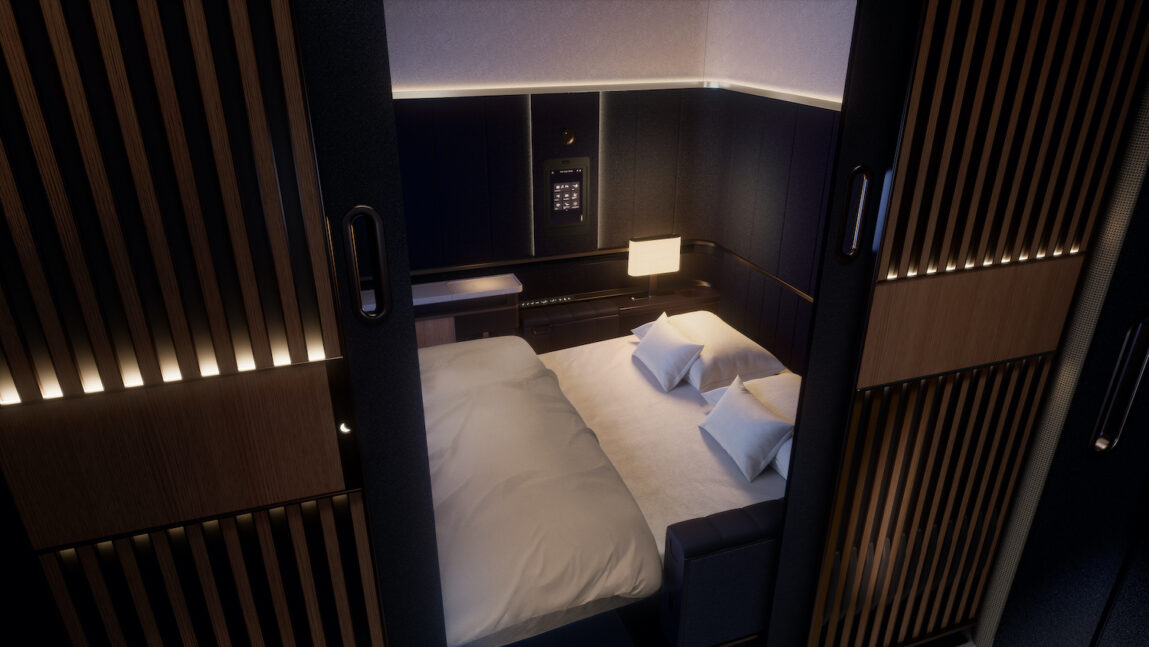TEXT Andres Damm | RELEASE IN CHAPTER №IX »WORK IN PROGRESS« – WINTER 2023/24
Permanent innovation, finely tuned product perfection and constant design adaptations are essential for companies today in order to remain at the top of the industry league in a turboglobalized world. The tourism industry is no exception here, but rather a spearhead of this development due to its international nature. Particularly in the luxury category of the hotel, aviation and cruise industries, constant further development is therefore part of the everyday life of quality managers and product developers, with factors such as sustainability and diversity playing an increasingly important role in their considerations alongside ongoing product innovation.
INDIVIDUALIZATION AT 10,000 ALTITUDE METERS
Nostalgics like to wax lyrical about the »golden age of flying«. From the sixties and seventies of the last century, when the time high above the clouds was still glamorous and noble. While this is certainly true for the majority of transportation classes, it must be put into perspective, at least for the front rows of long-haul jets: Flying here has never been as comfortable and luxurious as it is today. At the beginning of the millennium, completely flat beds were only occasionally found in First Class on some airlines, but today they are already standard in Business Class. Accordingly, in order to continue to set themselves apart, passengers in First Class on leading airlines today enjoy a truly private jet ambience in the form of luxurious suites. Staying at the forefront of quality, service and convenience is therefore becoming increasingly challenging, and not just because the pace of innovation in the industry is constantly increasing.

Flying private room in First Class: a look at Lufthansa’s latest cabin concept Allegris.
The First– and Business Class in Lufthansa’s latest cabin concept, which is marketed under the name Allegris focuses accordingly on attention to detail and, among other things, on innovations that are not visible at first glance. A truly unique selling point of the new long-haul product Allegris. The impressive variety of seating options on offer should be one of the main reasons for this: »With the Lufthansa Allegris we have developed a completely new cabin concept comprising 14 different seats in four classes, including two different seat types in the First– and seven different seat types in the Business Class«, explains Kai Peters, Head of Experience Design at the Lufthansa Group, in an interview with Chapter. Heterogeneity in cabin design, in other words, with which Lufthansa aims to meet the individually differing needs of passengers traveling in the same class of carriage. After all, passengers may have different requirements, even if they buy the same ticket.

The options in Lufthansa Business Class at Allegris include extra-long beds, a double seat in which two adjacent seats can be combined to form a double bed by means of a retractable center console.
The options in the Business Class belong to Allegris extra-long beds, a double seat in which two adjacent seats can be combined to form a double bed by means of a retractable center console, and in the First Class the particularly generous and private Suite Plus with floor-to-ceiling walls and lockable door, 43-inch screens across the full width of the suite and its own minibar and wardrobe. »Our newly introduced seat heating and cooling in First and Business Class is also a unique innovation in the industry,« explains Peters, but emphasizes that »cabin design at Lufthansa follows a holistic approach, with the same development team responsible for all classes«. This approach should also benefit Economy Class passengers, as various innovations will also be found in the rear section of Lufthansa aircraft. »Our latest in-flight entertainment system with 4K monitors will be available throughout the aircraft, and a newly developed lighting system that will help prevent jet lag and arrive fresher will also be installed throughout the cabin, regardless of class.« From 2024, the Allegris long-haul product will then be introduced with the newly delivered Airbus A350. Among other things, Lufthansa wants to set new standards in comfort and luxury in the highest class with the aforementioned »flying private room«. And the focus on very specific, individual needs in the premium segment also appears to be an exciting new way to further strengthen customer loyalty.
Emirates—traditionally a very innovative airline—is also aware of the fact that constant further development of cabin concepts, especially for the most expensive travel class, is essential in order to remain attractive for the demanding luxury target group. »Emirates has always set the bar for others,« says Abdulla Shams, Vice President Engineering Projects at Emirates, confidently in an interview with Chapter. »We can look back on a number of innovations in our company history: in 2003, we introduced the world’s first private suites on board; in 2008, we were the first airline to introduce an in-flight lounge and spa showers for First Class passengers. In 2007, Emirates was the first airline in the fleet to allow in-flight cell phone use, and in 2011 we were the first in the industry to introduce in-flight Wi-Fi for passengers. Emirates was also the first airline in the world to order the iconic Airbus A380. This has now become the flagship of our fleet and offers exquisite luxury in the air with its on-board lounge and spa showers.«
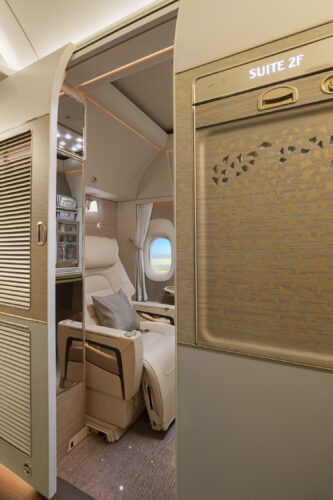
Private jet ambience: The developers of the recently presented Emirates First Class Private Suite were inspired by the (interior-) design philosophy of Mercedes-Benz.
The development of new First Class products is a lengthy process that can take up to five years from conception to market launch and requires an intensive exchange from the top management level to various interest groups and departments, including a wide range of data analyses and customer feedback. The credo is therefore never to be satisfied with the status quo, but always to plan several steps and many years ahead to ensure that the company continues to succeed as one of the market leaders in the luxury segment.
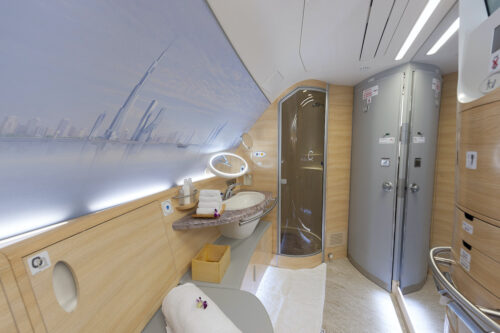
The iconic Airbus A380 is now considered the flagship of the Emirates fleet:
On-board lounge and spa showers offer exquisite luxury in the air.
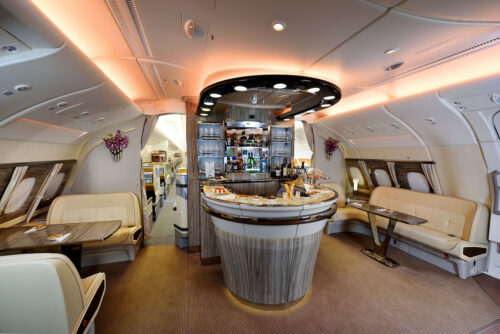
At the extraordinary on-board bar in the Emirates Airbus A380, First– and Business Class guests can relax with cocktails and snacks.
With this in mind, Emirates recently presented a new top-of-the-line product in the form of the new First Class Private Suite, for which the developers were also inspired by the (interior-) design philosophy of Mercedes-Benz. The exchange between automotive and aircraft designers makes perfect sense, as both industries face the same challenges when it comes to accommodating luxury and comfort in a limited space in the best possible way and at the same time having to take strict safety requirements into account. »The new Emirates First Class Private Suite was a game changer and has taken the passenger experience to the next level by offering a fully enclosed private space,« explains Abdulla Shams. »An industry first, the private suite features virtual windows for the suites in the middle of the aisle. Room service can be ordered at the seat via video call, and the temperature and mood lighting in the private suite can be individually adjusted.« According to the airline manager, the boundaries of the customer experience have been expanded time and again and Emirates intends to continue to do so in the future.
SUSTAINABLECLOSE TO NATURE
With a completely different focus on innovation, an international hotel group wants to continue to secure its place in the top league and set itself apart from its luxury hotel competitors. With currently only 21 hotels worldwide, Six Senses Hotels is one of the smaller players in the industry, but this is probably an advantage when it comes to giving the individual resorts their very specific character with a very strong connection to the location. This is particularly evident at the Six Senses Svart hotel, which is currently still under construction. The building will not only be the Group’s first climate-neutral, but also climate-autonomous project. In order to achieve this self-imposed standard, which is intended to satisfy the rapidly increasing demand for sustainable travel, the project has to break new ground in various areas. Attention was already paid to a low ecological footprint when selecting the materials. Organic products that guarantee low energy consumption after commissioning were at the forefront of the architectural concept.
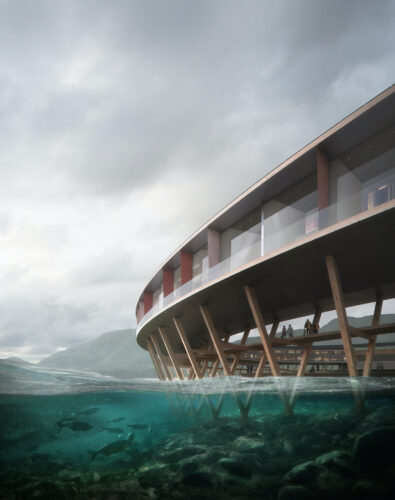
The Six Senses Svart, which is due to open in 2024, will be built on stilts, along which mussels will also be grown for the hotel’s own restaurant.
To minimize the ecological footprint on site, the Six Senses Svart stands on stilts over the waters of the Holandsfjord, with the Svartisen glacier stretching out behind it, an impressive backdrop into which the hotel with its 94 rooms blends in as subtly as possible. The boundary between land and fjord seems to blur.
How seriously the Six Senses Group is pursuing the climate neutrality project is not only evident on site in the far north, but also at the company headquarters: »Sustainable hotels require extraordinary creativity and Six Senses Svart takes us to a whole new level when it comes to pushing boundaries. The concept is bigger than the project itself, as it will be a futuristic showcase of what can be achieved in terms of sustainability and energy solutions,« says Neil Jacobs, CEO of Six Senses, explaining the group’s ambitions.

A concept bigger than the project itself: The Six Senses Svart in the north of Norway is pursuing the ambitious goal of being not only climate-neutral, but climate-autonomous.
The north of Norway was not chosen at random, but rather the ideal location for an off-grid destination. During the long Arctic summer days, enough solar energy can be generated to compensate for the energy consumption during the dark Arctic winters. An energy storage system also ensures that every watt of wasted energy can be captured and reused. The hotel will work with sustainable fishing companies and farms in the immediate vicinity for its gastronomy. The idea of growing mussels for the hotel’s own restaurant along the stilts on which the Six Senses Svart stands shows just how innovative, holistic and detailed the concept is planned in this area too. In total, 80 percent of the food will come from within a 50-mile radius, which will already have a huge impact on its carbon footprint. It almost goes without saying that the hotel will be plastic-free and serve guests filtered water in glass bottles, among other things.
TRANSFORMATIVE CRUISE
Despite the Covid-related, brief slump in the cruise boom of past decades, the industry is now flourishing again as ever. New target groups are constantly being developed and even more colossal ships are being built. Bigger, faster, higher has been the credo of recent years—a new superlative boat has constantly been launched. However, the success of the recent past also seems to be partly the curse of the industry. It sounds elitist, but it is not only a marketing challenge to sell an experience as luxury whose name also stands for cheap and mass tourism. Accordingly, if you want to focus on true luxury rather than mass, a comprehensive product strategy of differentiation seems essential.
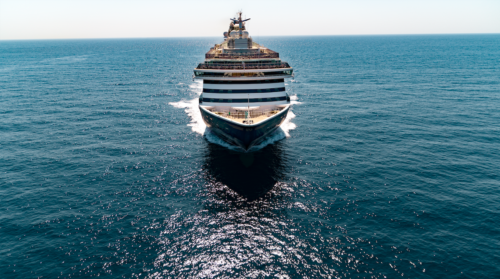
British designer Martin Francis is responsible for the exterior of the Explora I .
The Explora I, which just set off on its maiden voyage in August of this year, is not a mini boat at just under 250 meters long and 32 meters wide, but it is also far from being in the league of the largest ships. However, this was never the aim, because it is precisely the less enormous dimensions that allow maximum exclusivity on the ship. The sleek exterior of the Explora I, for which British designer Martin Francis was responsible, is more reminiscent of a private superyacht than a traditional cruise ship.
And the aura of the exclusive private ambience can also be experienced inside. Each suite measures at least 35 square meters, a considerable room size even on land; at sea, less exclusive competitors offer cabins that measure just a fifth of that. The slender silhouette of the Explora I not only gives it an elegant silhouette, but also makes it possible to completely dispense with the interior cabins, i.e. rooms without windows, that are otherwise common in the industry.
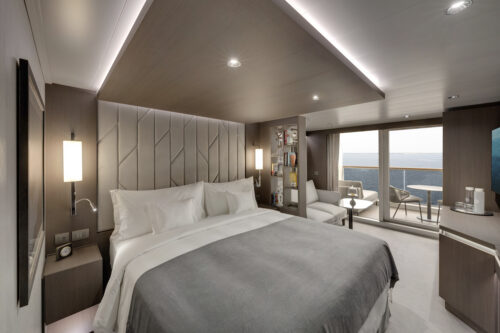
Thanks to the slender silhouette of the Explora I , it was possible to dispense with the usual inside cabins, i.e. rooms without windows.
The Owner’s Residence, by far the largest suite on board, also has an outdoor terrace that extends across the full width of the ship, including a private whirlpool with a panoramic view of the sea. The furniture here comes from Knoll and Molteni&C, among others—compared to other luxury cruise ships, the Explora I impresses with its sensual, purist modernity rather than its maritime, Art Deco style. From an ecological point of view, cruises are extremely controversial, even an exclusive approach cannot change this. But Explora Journeys is at least trying to find innovative solutions in the area of sustainability and minimize its impact on the marine environment. The Explora I is equipped with the latest environmental and marine technologies, including selective catalytic reduction technology, a shore power connection option, various underwater noise minimization systems to protect marine life, and a comprehensive range of energy-efficient on-board equipment to optimize engine operation and further reduce emissions.
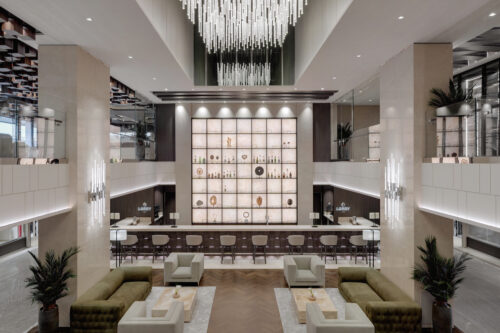
Sensual, purist modernity: The interior fittings of the Explora I come from Knoll and Molteni&C, among others.
During the maiden voyage in August this year, the route also made it clear that Explora I does not want to pay homage to mass tourism, but rather go its own way and swim its own way. Instead of sailing through the Mediterranean in the summer like most of the competition and calling at overcrowded port cities, northern Europe was chosen to allow guests to experience the 500 million Euro ship for the first time. The starting port was Copenhagen, from where a seven-day voyage took the guests through the landscapes of Lerwick on the Shetland Islands and Kirkwall on the Orkney Islands, before heading for Reykjavik. Not only are the destinations of the Explora I special, the ship also deliberately cruises at a slower speed. Slowing down is a concept that allows the impressions gained to be intensified.
»Ocean State of Mind« is how Michael Ungerer, CEO of Explora Journeys, describes this approach quite poetically: »Our aim is to offer transformative journeys that provide an opportunity for inner and outer discovery, inspired by the ocean and with physical, intellectual and spiritual renewal.« A thoroughly ambitious, but also very appealing destination for luxury accommodation on the high seas.

